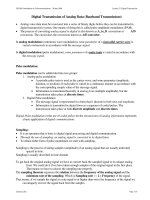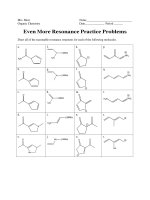Lecture 22 even more earthquakes
Bạn đang xem bản rút gọn của tài liệu. Xem và tải ngay bản đầy đủ của tài liệu tại đây (6.6 MB, 78 trang )
Chapter 10: Earthquakes (Part 3)
IN-CLASS EXERCISE
Observe the following objects as I drop them
on the floor and answer the following questions:
Objects:
- Clay
- Rubber Ball
- Ice Cube
Questions:
1) Which of these behaves as a brittle material?
2) As a ductile material?
3) As an elastic material?
4) Which of these material properties best accounts
for the generation of earthquakes?
Optional extra
credit assignment (20 pts):
The just released movie
“The Core” is loaded
with geology, some
of it accurate and some not!
Assignment:
Go and see “The Core” and
write a report that separates
geological fact from fiction!
Length of write-up: 2 pages
Use illustrations.
Due two weeks from today.
TODAY’S LECTURE
Detecting earthquakes.
Determining earthquake intensity
and magnitude.
Locating earthquakes.
Earthquake damage (with examples).
In summary: Types of seismic waves
Motion produced by the
different wave types
P-wave
S-wave
Surface-wave
Arrival times
of earthquake
waves.
Fig. 10.17
W. W. Norton
Seismology
Seismology
- The study of earthquake “waves”, earthquakes, Earth
seismic waves
Ancient
Chinese
seismograph
Instrument to
record seismic
waves
Seismogram - Recording of ground shaking from seismographs
Fig. 10.15
Seismograph
vs. seismogram
W. W. Norton
Electrostatic device:
Fig. 10.16
W. W. Norton
For measuring
vertical motion…
For measuring
horizontal motion…
Earthquake Intensity and Magnitude
Mercalli Intensity Scale
Qualitative scale to convey intensity of ground
Shaking & damage at a specific location
Depends on distance to earthquake.
& strength of earthquake.
Magnitude
An absolute measure of the energy released in
an earthquake
Depends on the amount of elastic energy
stored in the rocks prior to the earthquake
and the intensity of faulting to release
that energy.
Earthquake Magnitude & Intensity
Magnitude
An absolute measure of the energy released in an earthquake.
Intensity
A qualitative measure of intensity based on damage.
Magnitude
Intensity
Locating an Earthquake…
P-waves & S-wave travel at different speeds…
Fastest wave: Arrives first!
Basic Approach:
1. Measure time between P and S wave on seismogram.
2. Use travel-time graph to get distance to epicenter.
3. Draw circle on a map with radius of that distance.
4. Three or more circles should intersect at epicenter!
Fig. 10.18ab
W. W. Norton
Locating an Earthquake…
1. Measure time between P and S wave on seismogram.
2. Use travel-time graph to get distance to epicenter.
3. Draw circle on a map with radius of that distance.
4. Three or more circles should intersect at EQ!
Fig. 10.18c
W. W. Norton
Fig. 10.20
Earthquake Magnitude & Intensity
Magnitude
An absolute measure of the energy released in an earthquake.
Magnitude is measured at focus and is a non-linear scale…
That is, the increase in energy between each step is exponential.
Magnitude
Intensity
Fig. 10.21
Earthquake Damage
San Francisco, 1906
San Francisco 1906 Earthquake: Magnitude 8.3
Intense fire
damage area
San Francisco 1906 Earthquake: Magnitude 8.3









